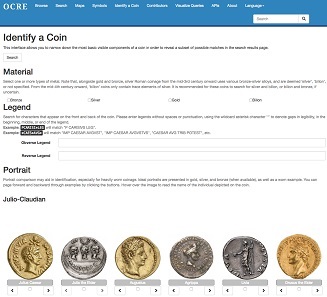May 18, 2017 – The American Numismatic Society (ANS) announces a new interface for Online Coins of the Roman Empire (OCRE), which allows non-specialists, hobbyists, collectors, archaeologists, and others to browse Roman Imperial coins by image for free online. People can compare the coins in their collections or those coins recovered from archaeological excavations against diagnostic specimens in OCRE. The OCRE project received $300,000 from the National Endowment for the Humanities (NEH) in 2014.
A screenshot of the user interface.
The “Identify a Coin” interface works on any device, from computers to tablets to smart phones. Users can begin browsing Roman Imperial coinage right away, or can filter results by portrait, material, and even legends, which includes the ability to enter all or part of a legend as well as marking illegible characters. The portraits are listed chronologically, first by dynasty, and then by personage within the dynasty (including empresses and children). In many cases, examples of portrait images are available in gold, silver, and bronze varieties, as well as worn examples that one may encounter with stray finds or excavation. More than one material may be chosen, which is useful for later Roman coinage, when severe wear makes it difficult to distinguish between what Roman Imperial Coinage has designated as “silver,” “bronze,” or “billon.” By clicking the left and right arrows below the image, it is possible to scroll through available portraits, which may show several phases of portraiture, such as Nero, who grew from a teenager into adulthood over the course of his reign.
OCRE’s “Identify a Coin” tool is one of the most complete depictions of numismatic Imperial portraiture online, and the ANS hopes that it will also prove itself a useful art historical tool to trace the development of Roman portraiture from the Augustan period through the Soldier Emperors to the Tetrarchy until the end of the Roman Empire.
Ethan Gruber, the ANS’s Director of Data Science, created the interface, and ANS Curatorial Assistant Disnarda Pinilla identified all of the portraits used in the tool. The ANS’s Associate Curator, Gilles Bransbourg, has overseen the OCRE project from its inception. Although primarily drawn from the ANS’s permanent collection of Roman Imperial coins, other specimens are included from the Münzkabinetts in both Berlin and Vienna, as well as from the Fralin Museum at the University of Virginia.
To test the new tool click here.
This is the OCRE homepage.
And for more information on the ANS go to the society’s official website.




